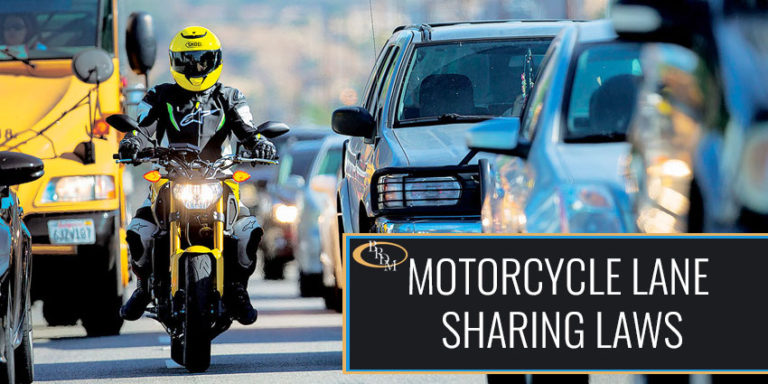Florida is one of the top motorcycle destinations in the country, hosting some of the biggest motorcycle events every year – Biketoberfest and Bike Week, which just passed. Some might argue that motorcyclists have more freedom than other motorists. In the US, motorcycles are not only a mode of transportation; they are also a form of recreational activity. As a result, we often see motorcycle riders in groups or riding alongside each other.
When you see motorcycles riding side-by-side, it’s called “lane sharing.” However, note that “Lane sharing” is different from “lane splitting” and “lane filtering.”
Lane splitting and lane filtering are often used interchangeably but are two different things. Lane splitting is when a motorcyclist rides in the space between two lanes of traffic. They usually do this to pass vehicles. Lane splitting is illegal in Florida.
Finally, lane-filtering is a modified version of lane splitting where motorcyclists keep moving to get around larger vehicles. They often do this at low speeds (under ten mph) when traffic slows down to get to the head of an intersection.
In this article, we’ll discuss the key differences between lane sharing, land filtering, and lane splitting and the laws in Florida around them.
Table of Contents
- Lane-Splitting and Lane-Sharing Laws in Florida
- Penalties For Motorcyclists Who Lane-Split in Florida
- Definition of Lane Sharing
- Explanation of Lane Splitting vs. Lane Filtering
- Could Lane Splitting Actually Be Safer for Motorcyclists in Traffic?
- Is the Motorcycle Rider Automatically at Fault for an Accident if They Were Lane Splitting?
- Contact a Florida Motorcycle Accident Lawyer Today
Lane-Splitting and Lane-Sharing Laws in Florida
Under Florida Statute 316.209(3)(4), there are strict regulations on the road for where and how motorcyclists can use lanes. For example, the statute states that “no person shall operate a motorcycle between lanes of traffic or in between vehicles.” Meaning lane splitting is illegal.
The statute also mandates no more than two motorcycles can ride alongside each other in a single lane. So, lane sharing is legal with limitations.
The exception to this rule is for Florida law enforcement officials, who do not need to follow the same traffic laws. Motorcyclists who violate Florida lane-splitting laws are subject to a citation for a moving violation.
Penalties For Motorcyclists Who Lane-Split in Florida
Motorcyclists who lane-split are subject to a ticket for a moving violation. They can also face fines of up to $500.00. For example, the fine in Hillsborough County is $153 but can be more in other countries.
Definition of Lane Sharing
When you see two motorcyclists riding adjacently or staggered horizontally in the same lane, that is lane sharing. In most states, including Florida, lane-sharing is legal. Remember, Florida Statute 316.209(3)(4) states only two motorcycles can share a lane. If three or more bikers share a lane, it’s illegal.
Since the average lane is only about 12 feet wide, it’s only safe for two motorcycles to share a single lane. Furthermore, it’s much safer to ride in a staggered formation than directly next to each other.
Explanation of Lane Splitting vs. Lane Filtering
Almost all of us have experienced a motorcycle passing on either side of our vehicle. This is lane splitting – when a motorcycle rides between traffic lanes. Lane filtering is simply a slower form of lane splitting. It’s when a motorcycle bypasses stopped or slowing vehicles to get to the front, but the difference is that the surrounding vehicles are traveling slower. So the difference between lane splitting and filtering is the context of the surrounding vehicles (for example, in the middle of moving traffic vs. at an intersection).
California is the only state where lane-splitting is legal, and Utah allows lane filtering. That’s because lane-splitting is dangerous for motorcycles and other motorists. Lane splitting is dangerous for several reasons:
- Motorcyclists end up in cars’ blind spots, making them harder to see
- Drivers may not see them in their blind spots and feel uncomfortable when they are unsure of the motorcyclists’ location.
- Not all drivers use turn signals, which can lead to a crash between a lane-splitting motorcycle and a car switching lanes.
While there are obvious dangers of lane-splitting, some people argue that motorcyclists are safer off lane-splitting. One argument is that they are less likely to get rear-ended by a car or stuck between two cars in traffic. Another belief is that lane-splitting and filtering can help reduce traffic congestion by allowing motorcycles to move to the front of the lane when other cars slow down.
Could Lane Splitting Actually Be Safer for Motorcyclists in Traffic?
Even if lane splitting is safer for the motorcycle under specific circumstances, it is still illegal. One situation when lane splitting might be safer for a motorcyclist is during rush hour traffic when vehicles stop and go a lot. To illustrate, think of two lanes of traffic going in the same direction, and one lane slows or stops completely.
In that case, the motorcycle could split lanes to continue driving rather than stay in the stopping lane and risk getting rear-ended or sandwiched between two vehicles.
Motorcycles that lane split are less likely to get injured in a traffic collision with another vehicle. When done safely, it can make the trip safer for the motorcyclist. The faster a motorcycle is going, the more dangerous it is to lane-split. And remember, lane splitting is illegal in Florida.
Is the Motorcycle Rider Automatically at Fault for an Accident if They Were Lane Splitting?
It depends on a few things. If the motorcycle was lane-splitting and hit another car, they are likely at fault. But, if another driver hits the motorcyclist while lane-splitting, they might both be responsible for the crash. This is when comparative negligence would become relevant.
Florida’s Comparative Negligence Law in a Lane Splitting Accident
The comparative negligence law in Florida means that multiple parties can share liability for an accident. So, if you were the motorcyclist in a lane-splitting accident, even if it was the other car that hit you, you might be partially responsible for your injuries for illegally lane-splitting. Additionally, you would need evidence to prove the other driver was negligent and somehow contributed to causing the accident.
Contact a Florida Motorcycle Accident Lawyer Today
Our Florida motorcycle accident lawyers have helped numerous motorcycle accident victims. While lane-splitting is illegal in Florida, if the other driver was negligent, we can help you hold them accountable for their contribution to the accident.
It’s likely that you suffered more severe damages than the other driver if you were riding your motorcycle. Call us today if you suffered injuries in a Florida motorcycle accident, as your initial consultation is free.



